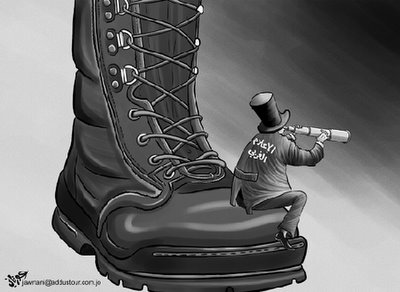On Scene: How Operation Swarmer Fizzled

Not a shot was fired, or a leader nabbed, in a major offensive that failed to live up to its advance billing By BRIAN BENNETT/AL JALLAM
Posted Friday, Mar. 17, 2006Four Black Hawk helicopters landed in a wheat field and dropped off a television crew, three photographers, three print reporters and three Iraqi government officials right into the middle of Operation Swarmer. Iraqi soldiers in newly painted humvees, green and red Iraqi flags stenciled on the tailgates, had just finished searching the farm populated by a half-dozen skinny cows and a woman kneading freshly risen dough and slapping it to the walls of a mud oven.
The press, flown in from Baghdad to this agricultural gridiron northeast of Samarra, huddled around the Iraqi officials and U.S. Army commanders who explained that the "largest air assault since 2003" in Iraq using over 50 helicopters to put 1500 Iraqi and U.S. troops on the ground had netted 48 suspected insurgents, 17 of which had already been cleared and released. The area, explained the officials, has long been suspected of being used as a base for insurgents operating in and around Samarra, the city north of Baghdad where the bombing of a sacred shrine recently sparked a wave of sectarian violence.
But contrary to what many many television networks erroneously reported, the operation was by no means the largest use of airpower since the start of the war. ("Air Assault" is a military term that refers specifically to transporting troops into an area.) In fact, there were no airstrikes and no leading insurgents were nabbed in an operation that some skeptical military analysts described as little more than a photo op. What’s more, there were no shots fired at all and the units had met no resistance, said the U.S. and Iraqi commanders.
The operation, which doubled the population of the flat farmland in one single airlift, was initiated by intelligence from Iraq security forces, says Lt Col Skip Johnson commander of the 187 Battallion, 3rd Combat Brigade of the 101st Airborne. "They have the lead," he said to reporters at the second stop of the tour. But by Friday afternoon, the major targets seemed to have slipped through their fingers. Iraqi Army General Abdul Jabar says that Samarra-based insurgent leader Hamad el Taki of Mohammad’s Army was thought to be in the area, and Iraqi intelligence officers were still working to compare known voice recordings and photographs with the prisoners in custody.
With the Interior Ministry's Samarra commando battalion, the soldiers had found some 300 individual pieces of weaponry like mortars, rockets and plastic explosives in six different locations inside the sparsely populated farming community of over 50 square miles and about 1,500 residents. The raids also uncovered high-powered cordless telephones used as detonators in homemade bombs, medical supplies and insurgent training manuals.
Before loading up into the helicopters for a return trip to Baghdad, Iraqi and American soldiers and some reporters helped themselves to the woman’s freshly baked bread, tearing bits off and chewing it as they wandered among the cows. For most of them, it was the only thing worthwhile they’d found all day.
Link Here




0 Comments:
Post a Comment
<< Home